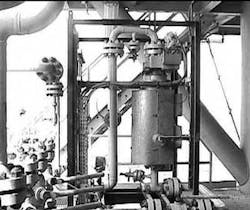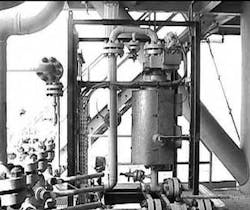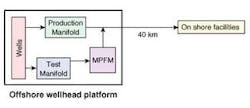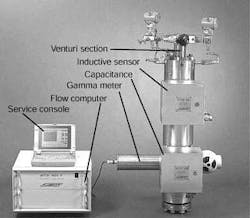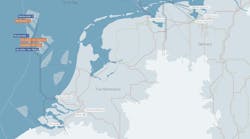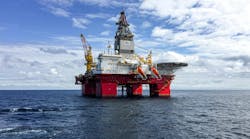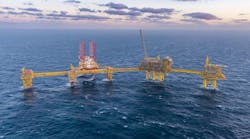At the beginning of the 1990s, a major research and development project to extend the capabilities of multiphase export was launched. This program included the simultaneous development of multiphase flow modeling, multiphase technology (qualification of multiphase pumps, development of multiphase meters, and subsea separation), and a new process to fight fluid-related effects such as hydrates, waxes, and others.
The initial aim was to simplify surface topside facilities, and to avoid installation of separators, pumps, compressors, and safety/flaring systems. In a second stage, this technology could be subsea deployed. The development of these different disciplines would help to avoid duplicate processing and huge infrastructures, and would ease remote controlled operation of unmanned platforms. The multiphase meter was one component of this global approach.
From 1991 to 1996, TotalFinaElf supported and tested multiphase meter prototypes. These were qualified on onshore fields. The application of an integrated multiphase approach to develop a Middle East offshore field reduced the investments and operating costs drastically.
In such a development, the multiphase meter found its place by eliminating the need for a dedicated testing flowline or a test separator and flaring system. Therefore, in 1997, their first multiphase meter on an offshore-unmanned wellhead platform was installed.
Meter application
The decision to use a multiphase meter was made in 1994-1995. Very few fields relied on a multiphase meter for well testing, without it being backed up by a test separator. The field layout comprises wells that are clustered on a wellhead platform. The production is sent to shore through a 40 km line. After separation, the oil is metered before custody transfer, which yields an excellent reference measurement.
The platform is unmanned. It has minimum facilities - production manifold, test manifold, and multiphase flowmeter (MPFM) 1900VI. The local operator interface of the meter is housed in the electrical room. The readings from the meter are also available onshore, through a low baud rate communication that carries all the control signals for the platform. The valves of the test manifold are not equipped with actuators.
Benefits
Monitoring of the multiphase flow at the wellhead eliminates the need for dedicated test lines from remote wellhead completions, as well as the need for a dedicated test separator at the processing facility. The meter replaces a test separator in its functionality.
A MPFM at the wellhead allows improved well control, hence better reservoir monitoring and well performance management. It is clear that extra information could be gained from the instantaneous feature of the measurement. For example, water slugs and gas slugs appear clearly in the readings of the remote wells. Continuous readings, instead of accumulated quantities given by test separator, will allow diagnostics of well behavior, and total recovery would probably be increased.
The capital expenditure savings have been estimated at US$800,000, compared to a test separator solution. In this application, the main savings came from the fact that the device saved the cost of the flare. The platform has no vessels to blow down.
This device helps in cutting operating expenditures as well. Despite the manually operated valves of the manifolds, it is possible to have each well tested monthly with only one visit per week. During a one-day visit, the production operator can test 2-3 wells, thanks to the short stabilization time of the meter. When leaving, the operator launches a 'long' test that will last until the next visit. A remote display allows for further analysis of the behavior of a given well. From a maintenance point of view, the meter is a low maintenance cost item, compared to a test separator.
Description
The multiphase meter used for this application is basically an instrumented pipe section, approximately 1.4 meters long, and with an internal diameter of 3 in. No separation and mixing is involved. The meter has been supplied as skid mounted, complete with inlet and return piping, with drain, vent, and drip tray for ease of calibration.
In order to limit any potential for clogging by wax and other materials within the meter itself, or in the pressure and differential pressure impulse lines, the complete instrumented pipe section has been heat-traced and lagged.
The multiphase meter is a Fluenta MPFM 1900VI, and consists of a capacitance sensor, an inductive sensor, a gamma densitometer, a venturimeter and a flow computer. The measurement principle is first to measure the density of the flow using a gamma densitometer. In oil-continuous flow (up to 60-70% water cut), the density measurement is combined with a measurement of the dielectric constant of the flow using the non-intrusive, surface plate, and capacitance sensor. Together, these two measurements provide the instantaneous composition of the flow at the measurement location.
At higher water cut, when water is the continuous liquid phase, the mixture conductivity is measured using an inductive type sensor. This then replaces the capacitance measurement in the composition calculation.
The velocity of the flow is determined by cross-correlation between different electrode pairs in the capacitance sensor. The cross correlation velocity may also be combined with the venturi meter, which extends the range of the multiphase meter to cover single phase liquid and annular flow, and also add redundancy to the velocity measurement in the intermediate range of gas volume fraction (GVF).
By combining both the compositional and the velocity information of the flow, the actual flow rates of oil, gas and water are determined by mathematical models hosted in the flow computer. The interphasial slip between liquid and gas is handled using the Dual Velocitytrademark method. This method is capable of handling complex flow regimes, including severe slugging, in-homogeneous phase distribution, and interphasial slip.
The non-intrusive design, together with the Dual Velocity method for handling phase slip, means the Fluenta multiphase meters do not require mixers to homogenize the flow, or a separator to split the flow, before measurement. This gives the meter a wide operating range, which is not limited by the efficiency of the upstream flow conditioner or splitter. Due to the limited interaction with the flow, pressure drop, erosion, and creation of emulsions that may otherwise affect the downstream process, are avoided.
Operational experience
The MPFM 1900VI was offshore commissioned in early 1997. Fluenta carried out this job with assistance from in-house specialists, especially for fluid parameters (oil and water density) determination. The duration of the commissioning/startup phase was about 10 days including training for the operators.
No test separator was available on the offshore platform for testing and verification. A static calibration procedure has been defined and implemented. This has been successfully applied to the meter to check the meter and make diagnostics. The procedure involves isolating the meter, emptying it and filling it with air, oil, and seawater. Since the fluid properties are known, this makes it possible to check the static response and calibration of the capacitance sensors, inductance sensor and gamma meter.
The MPFM is continuously in operation. During the weekly visit, wells to be tested are switched through the meter. A well test takes about one hour, and all the tests are validated before being entered into the database. In between weekly visits, the MPFM is left under flowing conditions with one well producing through the meter.
The man machine interface allows simple operation of the system. No systematic maintenance is carried out under normal operation. Verification of performance is done through regular follow up and comparison between well figures and total production.
The manufacturer has been called out once a year for calibration, and once for replacement of a display monitor and an electronic card on the inductive sensor. In four years, three interventions have been carried out by the manufacturer, mainly for capacitance and inductance sensors calibration.
The system has been operating successfully during four years without any problems. No failure has been recorded on sensors. The availability has been 100% since startup. The meter has been used during a short period of time only for liquid and gas measurements, due to a bias in the water cut measurement generated by incorrect water cut setting.
This indicates that care must be taken when calibrating MPFM with field measurements, which are not necessarily representative. This also indicates that even in such a case, the system still continues to provide data before reconfiguration or recalibration of some sensors.
The meter has been used for continuous recording of flow rates, gas fraction, and water hold up of wells for well behavior monitoring or for individual well test for reservoir management. Accuracy of the meter has been checked by both daily and monthly comparison with terminal figures. MPFM figures for oil and water have been in good agreement (average of less than +/-5% for oil, and +/-10% relative for water) with fiscal figures. Yearly figures show a difference of less than 1% between reference figures and multiphase meter figures.
Conclusion
The decision to install a multiphase flow meter instead of a test separator was governed by the low cost of such a development compared to alternative solutions. We have to recognize that the qualification was still in its final phase when the decision was made. The deployment of this equipment has allowed the unmanned operation of this platform. This technology has allowed a step-by-step approach. Today, additional multiphase flow meters have been ordered in the frame of an extension of the development.
Compared to the results we are accustomed to getting from a test separator, the figures, which are delivered by this equipment, are in the same range of accuracy. Furthermore, the detailed analysis of the gas/water/oil fraction distribution allows better knowledge of the flow conditions in the gathering system and in the flowlines. During transient operations (mainly startup operations), the increase of the water cut allows us to improve our understanding of the well near the well bore.
On this field, the deployment of a multiphase meter has contributed in improving the economy of the full project and improving our understanding of the hydrodynamics of the reservoir near the wellbore.
This experience demonstrates that the MPFM can be a very reliable solution for well testing and well monitoring; nevertheless success requires involvement of all people (project people, specialists, users) from design studies to operations. Also, support of manufacturers and a mutual understanding are key issues. Four years life time without failure shows that multiphase metering is now compatible with very demanding subsea and high water depths applications (sequences, tests, long term checks, cost impact).
References
Leggett B. et. al, "Multiphase Flow Meter Successfully Measures Three-Phase Flow at Extremely High Gas Volume Fractions - Gulf of Suez, Egypt," SPE 36837.
Caetano, E., Pinheiro, J., Moreira, C., Farestvedt, R., "MMS 1200 - Cooperation on a Subsea Multiphase Meter Application," OTC 8506.
Slater, S., Paterson, A., Marshall, M., "The development and use of a subsea multiphase flowmeter on the South Scott Field," OTC 8549.
Razali I., "Multiphase metering in Malaysia - Current and Future," 4th Annual International Conference - The future of multiphase metering.
Perry, D., Mitchell, M., Halvorsen, M., "Application of the First Multiphase Flow Meter in the Gulf of Mexico," SPE 49118.
Dykesteen, E., "Comparison of experiences from Multiphase Metering in different operations," IBC 1999.
Egner, E., Kalsaas, O., "Operational experience with multiphase meters at Vigdis," North Sea Flow Measurement Workshop, 1999.
Caetano, E., Dykesteen, E., "Operational experience with subsea multiphase meter," North Sea Flow Measurement Workshop, 2000.
Editor's Note: This is an updated and summarized version of OTC 13220, presented at the Offshore Technology Conference in Houston, Texas, May 2001.
